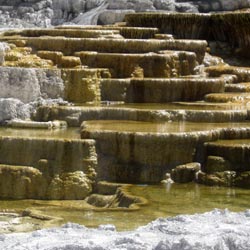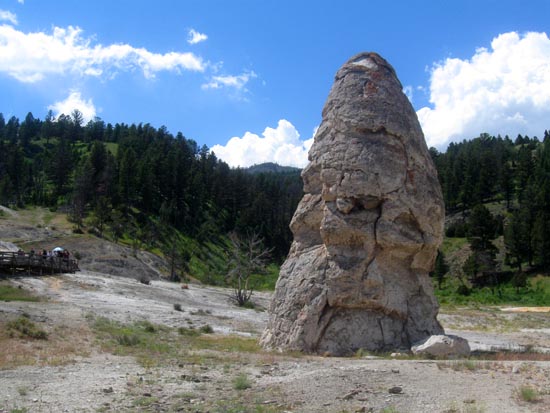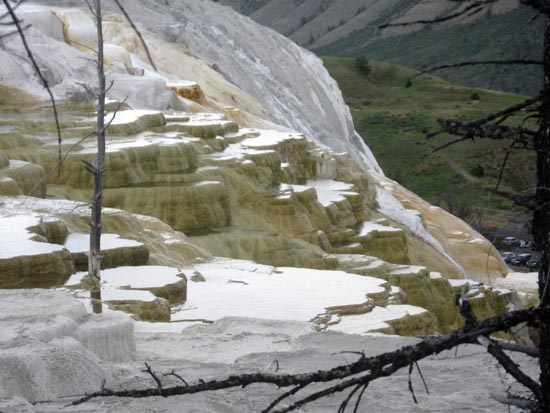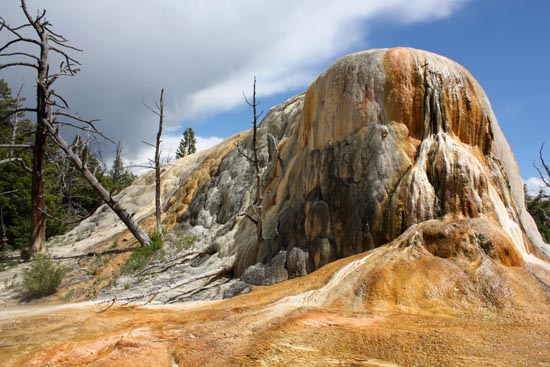


Hype:
The Mammoth Hot Springs area of Yellowstone is kind of out of the way from the rest of Yellowstone, but it is definitely worth the time. The travertine pools are unlike any other region of Yellowstone.
Trail Condition: Class 1 (Trail is either paved or gravel. Navigation skills are not needed because there is only one trail or because there are signs. Elevation gains are gradual or there are stairs.)
Time: up to 3 hours
Length: 1.7 mile driving loop, 0.8 mile round trip to Canary Spring, 1.4 mile round trip on Lower Terrace
Fees: Entrance fee
Recommended Ages:
 | 0-3 |
 | 4-11 |
 | 12-19 |
 | 20-49 |
 | 50-69 |
 | 70+ |
Recommended Months to Visit:
| Jan |
| Feb |
| Mar |
| Apr |
| May |
| Jun |
| Jul |
| Aug |
| Sep |
| Oct |
| Nov |
| Dec |
Navigate to 44.971397, -110.703239.
The following information was taken from the Mammoth Hot Springs Area Trail Guide![]() , which is available at the trailhead.
, which is available at the trailhead.
For hundreds of years, Shoshone and Bannock people collected minerals from Mammoth Hot Springs for white paint. These minerals contribute to the beautiful terrace structures, along with heat, a natural "plumbing" system, water, and limestone.
The volcanic heat source for Mammoth Hot Springs remains somewhat of a mystery. Scientists have proposed a number of sources, including the large magma chamber underlying the Yellowstone Caldera, or perhaps a smaller heat source closer to Mammoth.
At Mammoth, a network of fractures and fissures form the plumbing system that allows hot water from underground to reach the surface. The water comes from rain and snow falling on the surrounding mountains and seeping deep into the earth where it is heated. Small earthquakes may keep the plumbing open.
Limestone, deposited here millions of years ago when a vast sea covered this area, provides the final ingredient. Hot water with dissolved carbon dioxide makes a solution of weak carbonic acid. As the solution rises through rock, it dissolves calcium carbonate, the primary compound in limestone. At the surface, the calcium carbonate is deposited in the form of travertine, the rock that forms the terraces of Mammoth Hot Springs.
Thermophiles (heat-loving microorganisms) create tapestries of color where hot water flows among the terraces. Colorless and yellow thermophiles grow in the hottest water; orange, brown, and green thermophiles thrive in cooler waters. Colors also change with the seasons.
These terraces are like living sculptures, shaped by the volume of water, the slope of the ground, and objects in the water's path. They change constantly, and sometimes overnight?but the overall activity of the entire area and the volume of water discharge remain relatively constant.
Here, as in few other places on earth, rock forms before your eyes.
You can reach these terraces from boardwalks at their base or from Upper Terrace Drive. Some sections of boardwalk are wheelchair-accessible; the rest of the area has stairs or steep grades due to the terrain.
Look for this terrace across the road from the main trails?it plays an unusual role in Mammoth. In 1926, Opal began depositing up to one foot (0.3 m) of travertine per year. Its periodic growth threatens the historic house next door, which was designed by Robert Reamer and built in 1908 as an example of Frank Lloyd Wright's Prairie Style architecture. The National Park Service strives to protect both historic and natural resources?a challenge here.

Across the road from Opal Terrace stands the 37-foot (11 m) Liberty Cap, which was created by a hot spring that was active in one location for a long time. Its internal pressure was sufficient to raise the water to a great height, allowing mineral deposits to build slowly and continuously for perhaps hundreds of years.
Liberty Cap was named in 1871 by the Hayden Survey because it resembled the peaked knit caps symbolizing freedom and liberty during the French Revolution.

Water flows in crisscrossing patterns down a steep ridge where colorful thermophiles create a changing palette dominated by hues of orange and brown. This effect is much the same as an artist would achieve by allowing watercolors to run down a vertical surface.
Activity shifts dramatically around this terrace. The cascades of travertine beside the boardwalks were formed in the 1990s. Some years, they are dry. Whatever its level of activity, you can see why Minerva Terrace was named for the Roman goddess of artists and sculptors. Its ornate travertine formations create the look of layer cakes and lace-edged pools. In the dry areas, you can clearly see the many layers and the varying depths.

These terraces display cycles of activity typical of Mammoth Hot Springs. In 1937, Mound Terrace was called "the most beautifully colored spring." Inactive for decades, its weathered travertine shows new patterns where chunks of the soft rock have broken or fallen. Recently, Mound Terrace began flowing again. In the 1980s, Jupiter Terrace flowed heavily and overtook boardwalks several times.
Additional steps take you to the Upper Terraces, which you can also reach by car.
The entrance to the Upper Terrace Drive is two miles (3.2 km) south of the Albright Visitor Center on the Grand Loop Road. This one-way scenic drive winds for 1.5 miles (2.4 km) among hot springs and travertine formations.
Trailers, buses, and motor homes are prohibited on the drive due to limited parking and a narrow, winding roadway. Park these vehicles in the lot beside the Grand Loop Road, then enjoy the Upper Terraces on foot. Please stay on the road and boardwalks.
The first large parking areas offer views of Main, Minerva, and Cleopatra terraces. Also look for the red-roofed buildings of historic Fort Yellowstone, built and occupied by the U.S. Army while here from 1886 to 1918. (A self-guiding tour of the fort begins at the Albright Visitor Center.) Walkways lead to the Lower Terraces, to overlooks of Main Terrace, and to Canary Spring.

You can view this large terrace and its colorful springs from several vantage points. To your left, follow the boardwalk to an overlook of New Blue Spring. One of the best examples of the area's dynamic character, New Blue Spring shifts activity frequently and can become active or inactive several times in one year.
An overlook leads to a view of the entire Main Terrace; at the far right you can see Canary Spring. At the beginning of the trail to Canary Spring, a short spur trail takes you to a view of Cupid Spring, which has resumed activity recently. Continue on the trail to benches where you can relax and watch the waters and colors of Main Terrace. (This platform is also wheelchair-accessible, see map.)

You will likely find flowing hot water, new travertine formations, and shade as you walk alongside Canary Spring. Imagine you were here in the late 1800s, a time when yellow filamentous bacteria was prominent. Today, the spring exhibits the orange, brown, and green seen in other hot springs of the area. See the map for the location of the wheelchair-accessible trail to this site.
From the parking area, look south to Highland Terrace, which recently resumed activity.
This spring was active next to the road in the mid-1990s. In the mid-2000s, activity shifted toward the trees. And it may have shifted again by the time you visit.
Tree skeletons stand as monuments to a landscape created in the 1950s. This area has been inactive since the 1980s. Perhaps future visitors will see New Highland rejuvenated.

This spring flows from several vents from its top and side. Its striking colors come from the thermophiles living in the hot water.
Bath Lake was a popular swimming hole until it dried up in 1926. It filled again after the 1959 Hebgen Lake Earthquake and remained a lake through the 1970s. By then bathing in hydrothermal features was illegal because it destroys fragile formations and changes their activity.

Water laden with calcium carbonate has flowed from a fissure to build this ridge, which an early tour guide thought resembled the back of an elephant. Activity constantly shifts here.
The dramatic presence of this feature comes from abundant water, white formations, and colorful thermophiles that thrive in hot water. Angel Terrace was dry and crumbling for decades, but resumed activity in 1985. Some of the other dormant features you have seen on this drive may one day flow again too.
Closest City or Region: Yellowstone National Park, Wyoming
Coordinates: 44.971397, -110.703239
By Jeremy Dye
Jeremy Dye, Tara Dye, Savannah Dye, Greg Dye, Laura Dye, Zac Dye, Bryce Ball,
Brink of the Lower Falls Trail